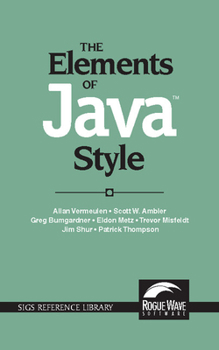The Elements of Java(tm) Style
Select Format
Select Condition 
Book Overview
The Elements of Java Style, written by renowned author Scott Ambler, Alan Vermeulen, and a team of programmers from Rogue Wave Software, is directed at anyone who writes Java code. Many books explain the syntax and basic use of Java; however, this essential guide explains not only what you can do with the syntax, but what you ought to do. Just as Strunk and White's The Elements of Style provides rules of usage for the English language, this text furnishes...
Format:Paperback
Language:English
ISBN:0521777682
ISBN13:9780521777681
Release Date:January 2000
Publisher:Cambridge University Press
Length:146 Pages
Weight:0.70 lbs.
Dimensions:0.4" x 5.0" x 7.9"
Customer Reviews
5 ratings
very brief and very handy
Published by Thriftbooks.com User , 23 years ago
Having gone through school at a university where Java replaced C++ several years ago, I've had about 4-5 years experience with Java by now. And the one bad thing I'll say about this book is that if you've been programming Java for a good while, most of what's in this little book is going to sound familiar and common sense.(just look at the summary in the back of the book and you'll be nodding your head at most of the conventions)But if you're learning Java, this book is full of subtle tips that will make your code at least look like it's been well-written. :-) Very good book describing a lot of things that experience can and will teach you, but not as nicely.
An excellent guide to Java coding standards
Published by Thriftbooks.com User , 24 years ago
This book is the marriage of Rogue Wave Java coding standards with those of Scott Amber. Standards are formulated as brief rules with one or more paragraphs of explanation, illustration, and justification.The first part of the book is devoted to general principles. There are just a few of these. For example, "Do it right the first time," that is, follow standards whenever you write code, even "throw-away" code.The second part is devoted to formatting conventions. These have to do with indentation, placement of openning and closing brackets, etc. I second the prohibition against hard tabs--use spaces instead. I've seen code written in an IDE that looks bizarre when viewed in a simple text editor like vi.The third part is devoted to naming conventions. Good naming conventions make code more nearly self-documenting. An example from this part is "Capitalize only the first letter in acronyms." For example, use "loadXmlDocument()" instead of "loadXMLDocument()," where the obvious exception is constant names which should contain only capital letters.Java facilitates a deeper integration of code and documentation (via JavaDoc) than most programming languages. The fourth part is devoted to documentation conventions--both JavaDoc and internal comments. If you have ever struggled with the wording of a JavaDoc comment you will appreciate the authors' no-nonsense advice.The fifth part is devoted to programming conventions. An example from this part is "Do not synchronize an entire method if the method contains significant operations that do not need synchronization," that is, use a synchronized block for the appropriate sequence of statements rather than synchronizing the whole method.The sixth part is devoted to packaging conventions. Package naming conventions are covered in part three. An example from this part is "Maximize abstraction to maximize stability." That is, use "stable abstractions to create stable packages."Consistently following standards such as those offered here will result in simpler, more understandable, more easily maintainable code, a worthy goal.
Very comprehensive do's and don'ts!
Published by Thriftbooks.com User , 24 years ago
This is an excellent quality work that can be used to instill quality in others. Don't bother writing up a long list of company do's and don'ts, just hand out this book. It covers coding style, documentation style, and lots of Java tips and techniques. It's exactly what I've been looking for, I just wish someone would write a similar book for HTML, XML, XSL, Transact-SQL, and all the other languages we use at work. This book is very concise, I was able to read it in a day, but it very heavily favored quality over quantity. I can't think of a tip that they left out, and every tip that needed illustration had an accompanying clear example. A perfect work and just what I've been needing.
Great little book.
Published by Thriftbooks.com User , 24 years ago
This book is a great compilation of many many little "secrets" and techniques from real Java projects. Chapters about documetation and packaging are really really good (the later is just 6-7 pages long but those are probably the most concise 6 pages I've ever read about package designing). If you read Sun's coding style recommendations for Java (available on Sun's site) and liked it, this is the book for you. It covers all other aspects of java programming using the same style.
All the right elements
Published by Thriftbooks.com User , 24 years ago
This book came along at the right time for me. It has all the right ingedients for standardising team coding styles and developemnt methods, including simple descriptions for their use. I recommend it to those in a similar situation or those who are looking to standardise their coding approach and create best practice standards. The real plus factor is that the book is small enough to read in a day, yet useful for a life time!





